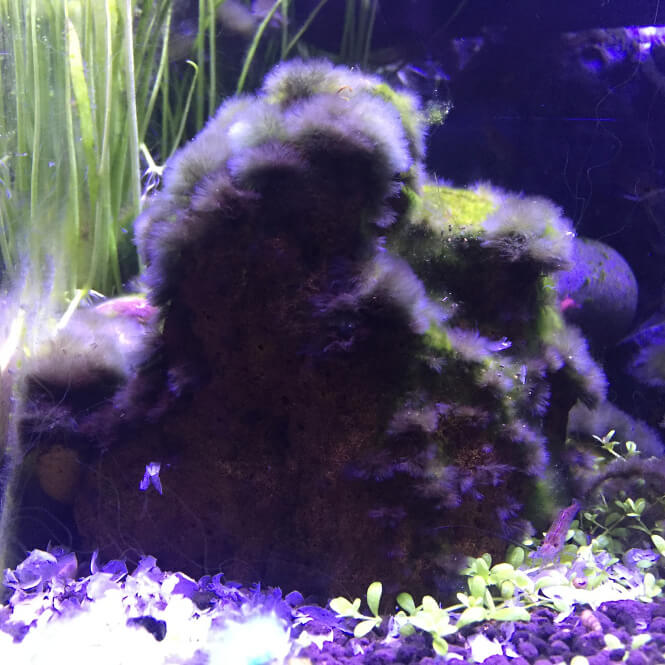Although it’s normal for algae to develop in any freshwater fish tank, it’s true that most aquarists don’t enjoy seeing them inside an aquarium. They come in various colors, such as red or black. Some aquarists even claim to see purple algae in their tanks.
That said, this may be surprising, but there’s no such thing as purple algae in freshwater fish tank. While there are many different types of algae, purple is not one of those. The more likely possibility is that this algae is a different algae altogether, and it may only look purple in a certain light.
Surprised? We’ll discuss this in more detail below!

Table of Contents
Are there purple algae in a freshwater fish tank?
As mentioned above, there’s no such thing as purple algae in a freshwater fish tank.
There are over 30,000 types of algae in the world, and they come in various colors, sizes, and forms.
The most common types are green, black, and brown. If you’ve been an aquarist for a while, there’s a good chance you’ve already seen these three.
Green algae can grow on the glass of the tank, as well as on the rocks and plants. They may even appear on the shell of your snails, if you have any. This type of algae grows in both freshwater and saltwater tanks.
Black algae grow in freshwater planted tanks. They’re particularly bad because they can quickly take over a tank or plant if left unattended.
Brown algae typically appear in new tanks. Although they’re very common, they’re also very easy to clean and remove.
Other colors include red, blue-green, and white.
Why is there purple algae in my tank?
Once again, there’s no such thing as purple algae, but there are some types of red algae that can take on a purple color. It’s also likely that whatever you’re looking at isn’t actually purple, but something else.
If you’re seeing what looks to be purple algae in your tank, there’s a good chance that it’s Black beard algae, a type of red algae that can make the list of the worst types of algae that can be found in any tank.

What are BBA algae?
Black beard algae, also commonly known as BBA algae or just BBA, is a type of algae that is notorious for being difficult to remove. Contrary to what its name implies, it’s actually a form of red algae that looks black in color.
They usually grow on plants that tend to grow slowly, such as Java ferns and Anubias. They start growing from the edges and eventually take over the entire plant, all while spreading to other parts of the tank, including rocks and wood.
The biggest problem with BBA is that it’s very hard to eradicate from the tank. Usually, it’s introduced to the tank alongside infected plants. Once it’s already inside the new tank, it will start wreaking havoc fairly quickly. This is especially true if the tank is too bright, or if the CO2 levels aren’t regularized. Additionally, if the water is highly polluted, BBA will spread faster.
Why is the BBA in my tank purple?
BBA can take on a black, dark-purple color inside the tank.
Purple or white BBA, however, is a sign that it’s already dead. It will still be in your tank until your remove it, but dead BBA can’t spread anymore. This is likely what people notice and mistake to be ‘purple’ algae, which technically doesn’t exist if we’re talking about algae types.
How to get rid of BBA algae
Although BBA is difficult to remove, that doesn’t mean it’s completely immune to other methods.
First of all, make sure that all your new plants are free of algae before putting them inside your tank.
Two, keep an eye on your tank conditions. Don’t use lights that are too bright, especially if your tank isn’t that deep anyway. You should also not keep the light on for more than 8-12 hours per day. Make sure to monitor your CO2 levels too, and to keep your tank as clean as possible at all times.
As for the stubborn BBA, you can remove them by scraping them off and then siphoning them from your tank. You should also cut the leaves of affected plants to prevent them from spreading even further. If the spread is already impossible to contain, you may have to clean out everything in your tank and start it from scratch.
Did this answer your question? Check out our other aquarium posts in this blog!